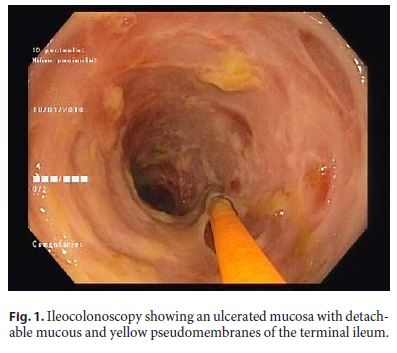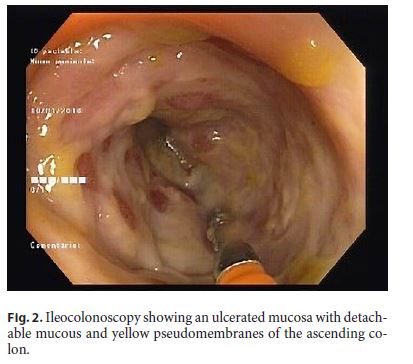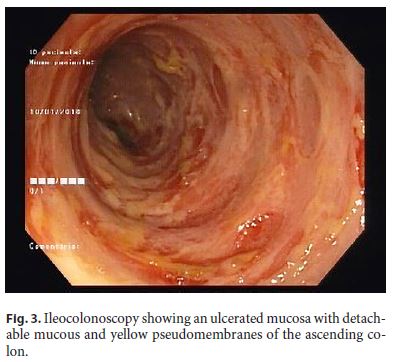Serviços Personalizados
Journal
Artigo
Indicadores
-
 Citado por SciELO
Citado por SciELO -
 Acessos
Acessos
Links relacionados
-
 Similares em
SciELO
Similares em
SciELO
Compartilhar
GE-Portuguese Journal of Gastroenterology
versão impressa ISSN 2341-4545
GE Port J Gastroenterol vol.26 no.6 Lisboa dez. 2019
https://doi.org/10.1159/000495766
IMAGES IN GASTROENTEROLOGY AND HEPATOLOGY
A Case of Colonic Graft-versus-Host Disease
Um caso de doença do enxerto versus hospedeiro do cólon
Joana R. Carvalho, Joao Lopes, Luís Carrilho-Ribeiro, Rui Tato Marinho
Department of Gastroenterology, Hospital de Santa Maria (CHLN), Lisbon, Portugal
* Corresponding author.
Keywords: Immunosuppressed patient, Graft-versus-host disease, Colon
Palavras-Chave: Doente imunossuprimido, Doença do enxerto contra o hospedeiro, Cólon
A 52-year-old male patient diagnosed with acute promyelocytic leukemia type M3 was submitted to bone marrow transplant 6 months ago. He presented with watery diarrhea with mucus and without blood (6 bowel movements a day) for the past 2 months and had lost 5 kg since the beginning of the symptoms. At physical examination, the patient was pale and presented with a diffusely painful abdomen, without rebound tenderness. The laboratory test showed pancytopenia with elevation of the sedimentation rate and C-reactive protein. Stool samples were negative for pathogenic bacteria and parasites. Abdominal radiography showed no signs of pneumoperi- toneum or hydro-aerial levels. An ileocolonoscopy was performed and revealed an ulcerated mucosa with detachable mucous and yellow pseudomembranes of the terminal ileum (Fig. 1), cecum, and ascending colon (Fig. 2, 3); the remaining colonic segments were normal. Multiple biopsies were performed and revealed ulceration and focal apoptosis, aspects compatible with graft versus host disease.



Graft-versus-host disease (GVHD) is a well-known complication of hematopoietic stem cell transplantation that can be life-threatening [1]. The incidence of GVHD after allogeneic bone marrow transplant ranges from 30 to 60% [2, 3]. Skin is the most commonly affected organ but, in rare cases, it can involve the gastrointestinal tract [2, 3]. The incidence of colonic GVHD is approximately 10% [3]. Diagnosis is confirmed by histology in the appropriate clinical context [1, 4]. As patients often present thrombocytopenia and colonic mucosa is easily detachable, colonoscopy with biopsies may carry some risk, and colonoscopy might be challenging [3]. In this context, Johansson et al. [3] reported that colonoscopy and sigmoidoscopy are equally effective for the diagnosis of colonic acute GVHD. However, our case is interesting because mucosal lesions were only seen in the proximal colon, and so a total colonoscopy was crucial for the diagnosis. Apoptosis is required to make the diagnosis of GVHD but is not a pathognomonic finding [1]. Differential diagnosis includes infectious colitis, which should be excluded [3]. Systemic corticoid therapy is the first-line treatment [1].
References
1 Ross WA, Couriel D. Colonic graft-versus-host disease. Curr Opin Gastroenterol. 2005 Jan;21(1):64–9. [ Links ]
2 Shidham VB, Chang CC, Shidham G, Ghazala F, Lindholm PF, Kampalath B, et al. Colon biopsies for evaluation of acute graft-versus-host disease (A-GVHD) in allogeneic bone marrow transplant patients. BMC Gastroenterol. 2003 Mar;3(1):5–5. [ Links ]
3 Johansson JE, Nilsson O, Stotzer PO: Colonoscopy and Sigmoidoscopy are Equally Effective for the Diagnosis of Colonic Acute Graft-versusHost Disease in Patients with Diarrhea after Allogeneic Stem Cell Transplantation: A Prospective Controlled Trial. Biol Blood Marrow Transplant. 2015 Dec;21(12):2086–2090. [ Links ]
4 da Costa LN, Costa-Lima C, de Meirelles LR, Carvalho RB, Colella MP, Aranha FJ, et al. Association between histopathological alterations and diarrhea severity in acute intestinal graft-versus-host disease. Medicine (Baltimore). 2018 May;97(19):e0600. [ Links ]
Statement of Ethics
The authors have no ethical conflicts to disclose.
Disclosure Statement
The authors have no conflicts of interest to disclose.
* Corresponding author.
Carvalho J.R.
Department of Gastroenterology, Hospital de Santa Maria (CHLN)
Av. Professor Egas Moniz
PT–1649-035 Lisbon (Portugal)
E-Mail joana.rita.carvalho@gmail.com
Received: October 23, 2018; Accepted after revision: November 26, 2018














